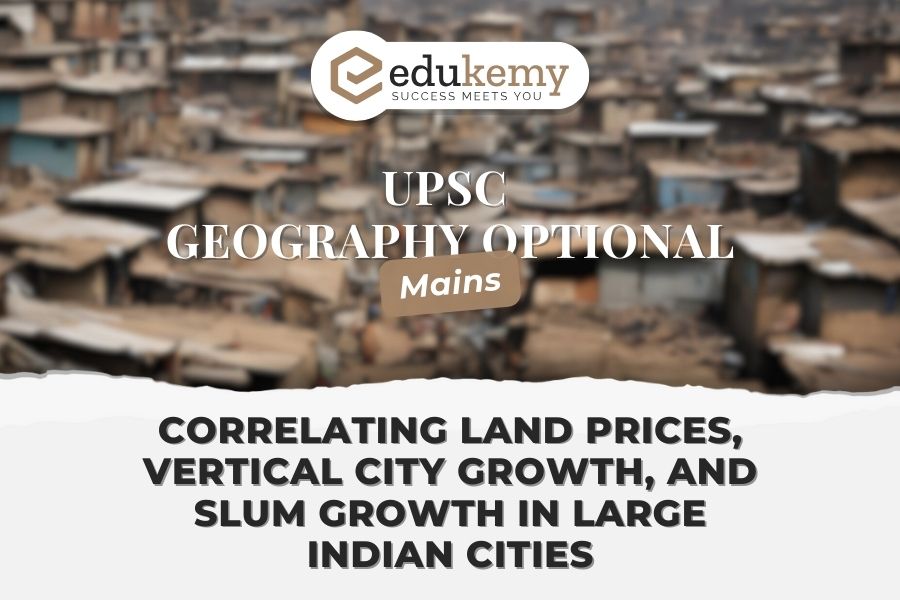
Explore the intricate correlation between land prices, vertical urban growth, and the proliferation of slums in India’s major cities. Analyze how skyrocketing land values drive vertical expansion, leading to the emergence of informal settlements in urban peripheries. Delve into the socio-economic factors fueling this phenomenon, including rapid urbanization, population influx, and limited affordable housing options. Understand the implications of slum proliferation on urban infrastructure, public health, and social cohesion. Examine policy responses aimed at addressing land affordability, promoting inclusive urban development, and improving living conditions in informal settlements. Gain insights into the complex dynamics shaping the urban landscape, highlighting the need for integrated approaches to housing and land management in India’s rapidly growing cities.
Contents
Answer:
Introduction:
In India, the dynamics of land prices, vertical urban growth, and the proliferation of slums are interlinked, shaping the urban landscape significantly.
Body:
- Land Price Pressure: As urbanization intensifies, demand for land escalates, driving up prices. This forces developers to maximize land use, often resorting to vertical expansion to accommodate growing populations.
- Example: In Mumbai, one of India’s most expensive real estate markets, land scarcity has led to soaring prices, prompting developers to build high-rise residential towers to maximize returns.
- Vertical Growth: Vertical expansion, epitomized by skyscrapers and high-rise buildings, becomes a common solution to accommodate urban populations within limited land areas. This phenomenon often occurs in tandem with economic growth and population influx.
- Example: Bengaluru, known as India’s Silicon Valley, has witnessed a surge in vertical growth with the proliferation of tech parks and high-rise office buildings to accommodate the influx of IT professionals and businesses.
- Rapid Urbanization and Slum Growth: The rapid influx of migrants from rural areas seeking better economic prospects exacerbates the housing shortage, leading to the growth of informal settlements or slums on the peripheries of cities. These areas often lack basic amenities and are characterized by overcrowding and substandard living conditions.
- Example: Dharavi in Mumbai, one of Asia’s largest slums, has burgeoned as a result of rapid urbanization and the inability of the formal housing sector to keep pace with the growing population.
- Informal Housing Solutions: Unable to afford formal housing due to high land prices, many low-income residents resort to informal housing arrangements, including squatting on vacant land or constructing unauthorized dwellings in slums and informal settlements.
- Example: In Delhi’s unauthorized colonies, residents build makeshift homes on government or privately-owned land, often without legal recognition or access to basic services like water and sanitation.
- Government Policies and Urban Planning: Inadequate urban planning and lax enforcement of building regulations contribute to haphazard urban growth, exacerbating issues related to land scarcity, slum proliferation, and vertical expansion.
- Example: In cities like Kolkata, where rapid urbanization has outpaced infrastructure development, unplanned growth has led to the emergence of slums in flood-prone areas, exacerbating vulnerability to natural disasters.
- Economic Disparities and Social Exclusion: The concentration of wealth and resources in urban centers exacerbates socio-economic disparities, leading to spatial segregation and the marginalization of slum dwellers, who often lack access to formal employment, education, and healthcare.
- Example: In Chennai, the spatial divide between affluent neighborhoods and slum settlements underscores the stark inequalities perpetuated by urbanization and land price inflation.
- Sustainability Challenges: The unchecked expansion of cities, driven by land speculation and vertical growth, poses sustainability challenges such as increased carbon emissions, strain on infrastructure, and loss of green spaces, exacerbating environmental degradation and urban sprawl.
- Example: In Bengaluru, rapid urbanization has led to the depletion of lakes and green spaces, exacerbating water scarcity and air pollution, while unplanned vertical growth has strained transportation networks and public services.
Conclusion:
These factors underscore the complex interplay between land prices, vertical urban growth, and the growth of slums in large cities of India, highlighting the need for holistic urban planning and inclusive development strategies to address the challenges of rapid urbanization and socio-economic inequality.
In case you still have your doubts, contact us on 9811333901.
For UPSC Prelims Resources, Click here
For Daily Updates and Study Material:
Join our Telegram Channel – Edukemy for IAS
- 1. Learn through Videos – here
- 2. Be Exam Ready by Practicing Daily MCQs – here
- 3. Daily Newsletter – Get all your Current Affairs Covered – here
- 4. Mains Answer Writing Practice – here

